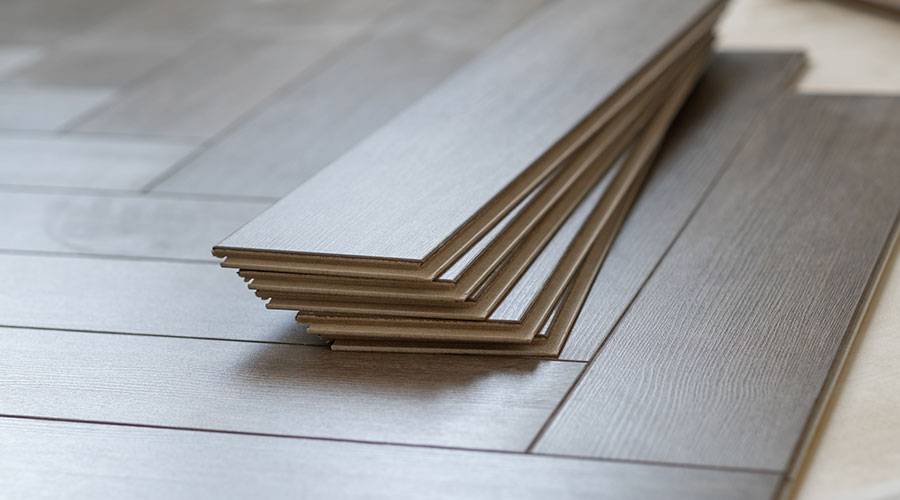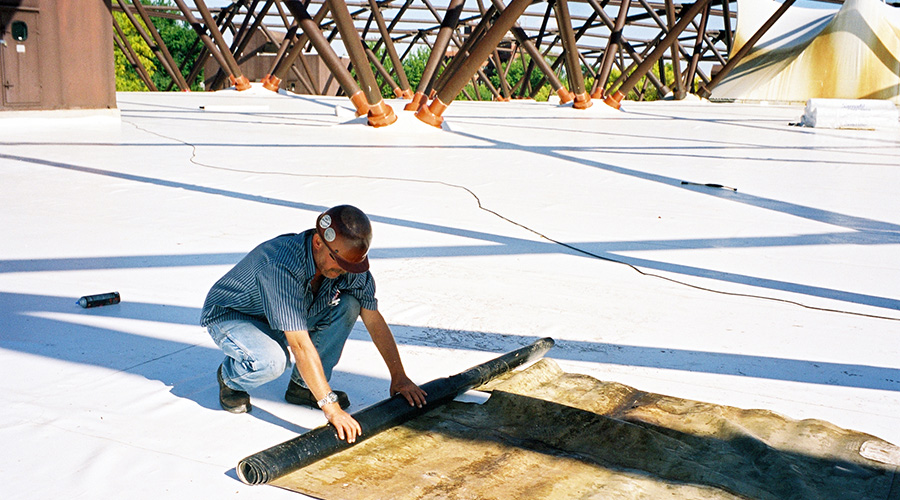Roofing
Reroofing: What Do You Get for Your Money?
One memorable commercial on television was an automobile mechanic who used the line, “pay me now or pay me later.” Does the same principle hold when it comes to reroofing a building? Does spending more now mean a longer lasting roof later? The answer is maybe yes and maybe no. There are no guarantees that spending more now will translate into spending less later. However, there is a very good chance that it will.
Why shouldn’t spending more produce a better quality roof? Wouldn’t spending more mean better materials, better design, better installation, better warranties? The answer is not necessarily.
With materials, cost is usually analogous to the quality of the roofing product, especially within the range of products offered by the same manufacturer. Roofing products manufacturers usually produce several grades of their own products, and there are definite cost differentials between commodity roofing products and products used when a roof is designed and specified for a particular situation.
The commodity products tend to be cheaper materials. The reason is that when no specifications are produced prior to bidding, and the contractor is asked for a price without guidance as to what to bid on, the contractor will tend to prepare its bid using the lowest-cost materials, the commodity roofs. This is understandable — roofing contractors do not make any money if they are not installing roofing. When price is the overriding criterion, cheap is better and more likely to win the job for the contractor. But cheap usually means thinner, less durable materials. If there is no upfront guidance on what should be installed, materials are chosen strictly by price.
Within each category of roofing products, thicker usually means better. Why? With flexible sheet membranes (a.k.a. single plies), the more material embedding the reinforcing scrim, the longer it takes the surface of the material to erode down to the scrim. This means it takes more time for the membrane to wear out.
In addition, thicker sheets can be fabricated with heavier reinforcing scrims for additional puncture resistance, which helps to prevent damage from foot traffic, dropped tools, etc. Cheaper flexible sheet membranes also tend to use more filler in their formulations than more expensive membranes. One way to keep the cost of the materials down is to use less of the expensive chemicals that improve pliability, UV resistance or fire resistance. All of these factors can reduce the life of the material on the roof.
With built-up membranes, “thicker is better” refers to the number of plies and not necessarily the measured thickness of the finished roof. It is possible for a built-up membrane to contain too much asphalt between the plies of reinforcing, in which case a thicker roof is actually not better. Generally, however, a thicker built-up roof means that there are more plies and more layers of waterproofing bitumen, so that it takes longer for the roof to wear out.
Modified bitumen membranes, often installed as cap sheets on built-up roofing plies, are generally longer lasting when thicker and when they contain more plies. More plies and thicker mats cost more. Exotic asphalt modifiers that change the physical properties of the asphalt cost more to produce but may extend the life of the roofing system because of these altered properties.
Boosting Returns With Insulation
One upgrade on a roofing system that generally has an immediate benefit is insulation. The cost of thicker insulation is generally not a great deal more than thinner layers. Higher R-values are not much more expensive than lower R-values. Insulation, especially where the roof area is extensive, can reduce heating and cooling bills enough to pay back the cost of the insulation in a few heating and cooling seasons.
Sheet metal accessories are another material used on the roof where a small increment in the cost may result in a much longer-lasting product. If a few extra cents per square foot are spent to upgrade from galvanized steel to stainless steel or aluminum, the metal will not corrode as fast and will last longer. A thicker metal sheet can also add durability. However, upgrading to a heavier gauge of metal may increase the cost without benefit, since the extra cost may be due to the increased difficulty of bending and handling the metal.
As a general rule, an upgrade in the materials usually means an upgrade in the quality of the roof system. This upgrade generally comes for only a modest additional cost. The cost of labor generally does not increase when the product is upgraded, nor do upfront costs incurred by the contractor for moving materials and equipment to the site, pulling permits, overhead or profit. Only the cost of the materials is different. To see what benefit a better quality and more expensive material will bring, consider the warranties offered by the manufacturers — a 10-year life vs. 15, for example.
So when isn’t the more expensive material a wise choice? If the investment goal of the owner is to sell the building in five years, it makes no economic sense to put on a premium roof material with a premium cost.
Another reason is that some roofing manufacturers inflate the price of materials and give the customer “free” consulting services. Although in some instances the materials are superior, in many cases the materials are the same as other manufacturers’ products; they may be just a private label of another manufacturer’s product.
Design Considerations
Does commissioning an architect or engineer to prepare construction documents mean a better roofing project? Does paying higher fees mean a better set of documents, better bidding assistance, better construction administration and, by extension, a better roofing project? Generally, yes.
Consider construction documents. A good set of construction documents should address the myriad constraints of existing conditions, codes, insurance requirements and budget; the issues of availability of materials and manpower to install the job; the choices of materials; and such other issues as attachment methods, seaming methods, surfacing, chemical compatibility and vapor retarders. Then the details have to be devised to be sure the penetrations will receive proper treatment. These and other items that will affect the work should be anticipated and dealt with before construction has started. All this takes time, and the cost is greater when more time is spent.
Relying on the contractor for all this may be penny-wise and pound-foolish. Even when a contractor knows what is best for a roof, that may not be what the contractor bids. If a facility executive is just calling in contractors to give prices without providing clear bidding documents, roofers know that the facility executive is not really looking for the best solution, but rather the cheapest price. That is what they will deliver — maybe not all the bidders, but at least one. And when low price is the goal, the low bid will win. If quality is the objective, the facility executive should consider spending the extra money — from 5 to 10 percent, depending on the number and type of services rendered — to have a professional involved in the preparing of construction documents, bidding the work, administering the contract and observing the installation.
When doesn’t design pay for itself? The answer is when the extra investment doesn’t produce better documents, bidding assistance and so forth. In many jurisdictions, there are no licensing requirements for roof consultants. Another potential problem is that the architect or engineer may not have a good understanding of what a reroofing project involves. That can be true even if they have designed hundreds of roofs on new construction. The result can be inferior work.
Another potential pitfall is bidding professional services. That approach will not save money unless the services being bid are exactly equal in scope, the services are sufficient to provide enough information to the contractors, and providers have the requisite knowledge to do the work. What one consultant is bidding may be a sketchy outline of the roofing work to be performed while another one may be proposing to provide a full set of construction documents complete with details, roof plans and specifications. Though both can be considered “specs,” they are clearly not the same thing.
Better Installation
Finally, there is the question of installation. Everyone wants the contractor to charge as little as possible. Is it worth the money to spend extra to get a good contractor? If indeed the result of spending more is getting a better quality contractor, the answer is emphatically yes. But there is a very large caveat. Higher cost may just mean higher profit margins, not better quality. A roof consultant may know who the better contractors are and whether their higher bids are worth the extra money.
Good contractors do have costs that other contractors will not, including training, insurance and workers compensation, salaries to keep superior mechanics in an employee-driven job market, and equipment. All these things add up, but without them, the contractor cannot provide superior work.
In addition, it takes time to do the details that make the difference between long roof life and a short-term disaster. For example, smearing roofing cement on a penetration will seal it temporarily, but taking the time to install a proper flashing will seal it for as long as the rest of the roof lasts. It increases the contractor’s production time to do the work right, which means it costs more in the contractor’s proposal.
When there are no construction documents from which the contractor will bid the work, the lowest-cost proposal will contain the cheapest methods of sealing penetrations, such as pitch pans rather than metal flashings or lapped joints in gravel tops rather than cover plates at seams. Such small items will cost less but will lead to maintenance headaches and extra cost in the future.
So when is it better to pay a contractor less? When all of the prequalified contractors are bidding the same scope of work with the same materials and methods, the best price really is the best price.
The old saying that you only get what you pay for is true in roofing. Quality costs more in the beginning — quality materials, good design and good installation are key. Quality takes time and costs a little bit more, but the small increment in upfront price is usually worth paying. The savings occur in the long term — when the roof does not have to be replaced as quickly, when tenants are happier with a dry building and when the facility executive can go home at night without worrying about that 3 a.m. call, “The roof is leaking — again.”
Karen L. Warseck, AIA, is president of Building Diagnostics Associates, a Hollywood, Fla., architecture firm that specializes in building repair consulting. She is a long time contributing editor to Building Operating Management on roofing and exterior wall issues.
Related Topics:











